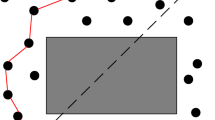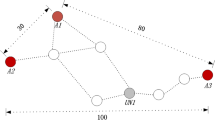Abstract
The original DV-hop algorithm performs pretty well in isotropic Wireless Sensor Networks in which nodes distribute uniformly. However, the localization accuracy degrades severely in anisotropic networks caused by uneven nodal distribution or irregularity of deployment region. In this paper, we propose a novel DV-hop algorithm based on Locally Weighted Linear Regression (LWLR-DV-hop), in which kernel method is adopted to improve the localization accuracy by raising the weight of neighboring anchor nodes. In the simulation section, algorithms are evaluated within two deployments and three topologies: the regular and random deployments, the L-shaped, O-shaped and X-shaped topologies. As performance metrics, the Average Localization Error and the Cumulative Distribution Function are used. The results of simulation and experiment reveal that LWLR-DV-hop performs better than original DV-Hop in anisotropic networks of different topologies, in which localization accuracy is improved by about 40% on average.















Similar content being viewed by others
References
Livinsa, Z. M., & Jayashri, S. (2017). An optimized analysis of localization algorithm in wireless sensor networks. Wireless Personal Communications, 6, 1–17.
Gui, L., Zhang, X., Ding, Q., Shu, F., & Wei, A. (2017). Reference anchor selection and global optimized solution for dv-hop localization in wireless sensor networks. Wireless Personal Communications, 1, 1–11.
Zhang, J., Tang, J., Wang, T., & Chen, F. (2017). Energy-efficient data-gathering rendezvous algorithms with mobile sinks for wireless sensor networks. International Journal of Sensor Networks, 23(4), 248–257.
Kutner, M. H., Nachtsheim, C. J., & Neter, J. (2004). Applied linear regression models (5th ed.). Technometrics, 26(4).
Gu, B., Sheng, V. S., Tay, K. Y., Romano, W., & Li, S. (2014). Incremental support vector learning for ordinal regression. IEEE Transactions on Neural Networks & Learning Systems, 26(7), 1403.
Gui, L., Val, T., Wei, A., & Dalce, R. (2015). Improvement of range-free localization technology by a novel dv-hop protocol in wireless sensor networks. Ad Hoc Networks, 24, 55–73.
Han, G., Chao, J., Zhang, C., Shu, L., & Li, Q. (2014). The impacts of mobility models on dv-hop based localization in mobile wireless sensor networks. Journal of Network & Computer Applications, 42(6), 70–79.
Nagpal, R., Shrobe, H., & Bachrach, J. (2003). Organizing a global coordinate system from local information on an ad hoc sensor network. information processing in sensor networks. Berlin, Heidelberg: Springer.
Liu, X., Zhang, S., Wang, J., & Cao, J. (2011). Anchor supervised distance estimation in anisotropic wireless sensor networks. In IEEE Wireless Communications and Networking Conference (Vol. 34, pp. 938–943). IEEE.
Poggi, C., & Mazzini, G. (2003). Collinearity for sensor network localization.In Vehicular Technology Conference, 2003. Vtc 2003-Fall. 2003 IEEE (Vol. 5, pp. 3040–3044). IEEE.
Wu, L., Meng, Q. H., Huang, J., & Liang, H. (2009). An improvement of DV-Hop Algorithm Based on Collinearity. In International Conference on Information and Automation (pp. 90–95). IEEE.
Bu, K., Xiao, Q., Sun, Z., & Xiao, B. (2012). Toward collinearity-aware and conflict-friendly localization for wireless sensor networks. Computer Communications, 35(13), 1549–1560.
Zhang, Y., Xiang, S., Fu, W., & Wei, D. (2014). Improved normalized collinearity dv-hop algorithm for node localization in wireless sensor network. International Journal of Distributed Sensor Networks, 2014(11), 1–14.
Zhong, You-ping, Kuang, Xing-hong, & Huang, Pei-wei. (2010). Multihop range-free localization in anisotropic wireless sensor networks: a pattern-driven scheme. IEEE Transactions on Mobile Computing, 9(11), 1592–1607.
Liu, X., Zhang, S., Wang, J., & Cao, J. (2011). Anchor supervised distance estimation in anisotropic wireless sensor networks. In IEEE Wireless Communications and Networking Conference (Vol. 34, pp. 938–943). IEEE.
Zhang, S., Wang, J., Liu, X., & Cao, J. (2012). Range-free selective multilateration for anisotropic wireless sensor networks. In Sensor, Mesh and Ad Hoc Communications and Networks (Vol. 1, pp. 299–307). IEEE.
Zhang, S., Liu, X., Wang, J., Cao, J., & Min, G. (2015). Accurate range-free localization for anisotropic wireless sensor networks. Acm Transactions on Sensor Networks, 11(3), 51.
Oh, S., Montanari, A., & Karbasi, A. (2010). Sensor network localization from local connectivity: Performance analysis for the MDS-MAP algorithm. In Information Theory (pp. 1–5). IEEE.
Wang, J. Z., & Jin, H. (2009). Improvement on APIT localization algorithms for wireless sensor networks. In International Conference on Networks Security, Wireless Communications and Trusted Computing (Vol. 1, pp. 719–723). IEEE Computer Society.
Liu, Y., & Yang, Z. (2011). Location, localization, and localizability. New York: Springer.
CC2420. 2.4 ghz ieee 802.15.4/zigbee-ready rf transceiver. http://focus.ti.com/lit/ds/symlink/cc2420.pdf. Accessed 12 January 2017.
Acknowledgments
The work is partially supported by the National Natural Science Foundation of China (No.61375121), the Natural Scientific Research Funds for Jiangsu Universities (Nos.17KJB520008, 17KJA520001), the Scientific Research Foundation of Jinling Institute of Technology (Nos. JIT-B-201429, jit-rcyj-201505, JIT-2016-jlxm-20), and sponsored by the Funds for Innovation Team of Swarm Computing & Smart Software led by Prof. SB Su (Corresponding Author).
Author information
Authors and Affiliations
Corresponding author
Ethics declarations
Conflict of interest
The authors declare that there is no conflict of interests regarding the publication of this paper.
Rights and permissions
About this article
Cite this article
Zhao, W., Su, S. & Shao, F. Improved DV-Hop Algorithm Using Locally Weighted Linear Regression in Anisotropic Wireless Sensor Networks. Wireless Pers Commun 98, 3335–3353 (2018). https://doi.org/10.1007/s11277-017-5017-2
Published:
Issue Date:
DOI: https://doi.org/10.1007/s11277-017-5017-2




